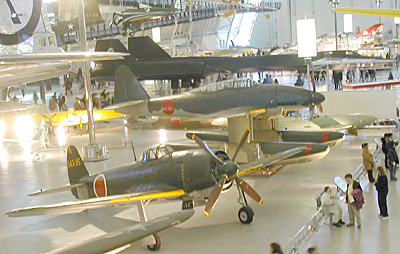
Although not the exact specifications as the Aichi M6A1 Seiran, the E13A1 probably served as a baseline for the M6A1. If I recall the display plaque, the M6A1 was meant to be deployed from a submarine.
The E13A resulted from a 1937 requirement for a long-range reconnaissance floatplane and first flew in prototype form during 1940. This paved the way for the E13A1 initial production model that entered service late in 1941. Production by three manufacturers totalled 1418 including an unknown number of prototypes, and these machines were delivered in variants such as the E13A1 baseline model, E13A1-K dual-control trainer, E13A1a with detail improvements as well as exhaust flame-dampers in a nocturnal subvariant, and E13A1b with air-to-surface radar.
"Japanese Row." Well, that's what I call it, anyway. In the foreground, the N1K2 "George", behind which is the Aichi M6A1 Seiran (floatplane). Peeking out from behind that is the Cherry Blossom jet kamikaze, which made its first flight on August 7, 1945.
Numbers of E13A1a and E13A1b floatplanes were later adapted to the light anti-ship role with a 20mm cannon in a trainable downward-firing installation. The aircraft in Imperial Japanese Navy service regularly undertook patrol sorties lasting up to 15 hours, but many came to a rather ignominious end during the latter stages of the war on kamikaze operations.
Country of origin: Japan
Type: (El 3A1a) three-seat reconnaissance floatplane
Powerplant: one 1080hp (805kW) Mitsubishi Kinsei 43 14-cylinder two-row radial engine
Performance: maximum speed 377km/h (234mph); climb to 3000m (9845ft) in 6 minutes 5 seconds; service ceiling 8730m (28,640ft); range 2089 km (1298 miles)
Weights empty 2642kg (5825lb); maximum take-off 4000kg (8818lb)
Dimensions: span 14.50m (47ft 7in); length 1 1.30m (37ft 1in); height 4.70m (15ft 5in)
Armament: one 20mm trainable downward-firing cannon in the ventral position (field modification on late-production floatplanes), and one 7.7mm trainable rearward-firing machine gun in the rear of the cockpit, plus an external bomb load of 250kg (551lb)
Specs and description from: Aircraft of WWII by Chris Chant (Fiedman/Fairfax, 1999, ISBN: 1-58663-303-1), a handy book covering 300 aircraft.
WWI
WWII
Japan: Kawanichi N1K2-Ja Shinden Kai (George)
US: Curtiss P40 Tomahawk
Post WWII
US: Northrop N-1M Flying Wing
Other
UHC Displays
Germany: Focke-Wulf FW-190F
Germany: Arado AR-234B
Germany: Junkers JU-52/3m
Germany: Focke-Achgelis FA-330A
Germany: Rheintochter R1 Anti-aircraft Missile (Rhine Maiden)
Japan: Kawasaki Ki-45 Kai Toryu (Nick)
Japan: Aichi M6A1 Seiran
Japan: Kugisho Ohka Model 22 Cherry Blossom
US: Vought F4U Corsair
US: Lockheed P-38J Lightning
US: Boeing B-29 Superfortress "Enola Gay"
US: Grumman F6F Hellcat
US: Republic P-47D Thunderbolt
UK: DeHavilland DHC-1A Chipmunk
US: Lockheed SR-71 Blackbird
US: Space Shuttle "Enterprise"
US: Lockheed Martin X35b Joint Strike Fighter
Back to List of Historic Sites
Back to Travel Master List
Back to MagWeb Master List of Magazines
© Copyright 2004 by Coalition Web, Inc.
This article appears in MagWeb.com (Magazine Web) on the Internet World Wide Web.
Other articles covering military history and related topics are available at http://www.magweb.com